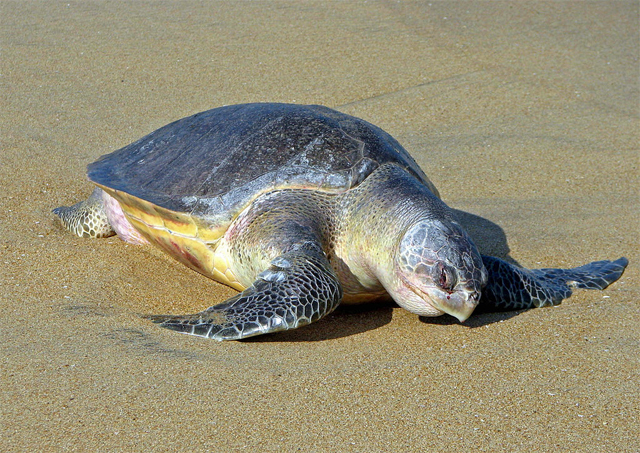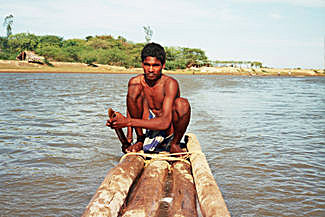Nearly 80 Yanadi are participating in a program of monitoring the safety of Olive Ridley turtle eggs until they hatch and the babies can safely enter the sea. The fishing people living on the coast of Andhra Pradesh were singled out last Thursday by a major Indian newspaper for protecting the eggs, which have been relocated into hatcheries in inaccessible beach locations along the Bay of Bengal coast of the Krishna Wildlife Sanctuary, southeastern India. When they hatch in May, the baby turtles will be released into the water.

Through January 27, people monitoring the beaches of the sanctuary observed 23 turtles that had crawled up from the sea and laid their eggs in the sand. Over the course of the four additional days until the end of the month, a few more turtles were spotted laying eggs. Since the turtles lay an average of 120 eggs at a time, wildlife authorities estimate that close to 3,000 eggs have been laid.
After laying their nest of eggs in the beach sand, the adult turtles go back out to sea. Sea birds stay on the lookout for the eggs to eat, as do a variety of other animals such as wild dogs, boars and jackals. The forestry officials in charge of the turtle egg program for the wildlife sanctuary moved the eggs for their own protection to nine different hatcheries in six places within the reserve, including Suryalanka Beach, Sangameswaram, and four others. Each hatchery is fenced and covered to protect the eggs until they hatch.

The turtle eggs are further protected by the Yanadi fisher folk, who have to use boats to reach the remote beaches where the hatcheries are located and then walk several kilometers to the new nest sites. The authorities provide essential commodities every week for the Yanadi nest watchers until late May when the hatchling turtles are released into the sea.
The basic instinct of the baby turtles after hatching is to rush down the beach and swim away. While these baby turtles will not be exposed to the hazards of their brethren on the beaches due to the interventions of the Yanadi and the other human protectors, they will still be preyed upon in the ocean. About one in 1,000 hatchlings will survive until adulthood, when they will try to come back to coastal Andhra Pradesh and build their own nests on their natal beaches.

A spokesperson told the newspaper that the agency was hoping it would be able to release into the sea more than 200,000 turtles in all from southeastern India during the upcoming hatching season. A news story in a major Indian newspaper last year also described the same program of protecting Olive Ridley turtles by the government and the Yanadi. Hopefully, the news coverage last week will enhance the reputation of the coastal Yanadi and encourage them to continue helping to protect an important species of wildlife.